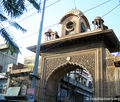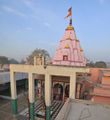Shodas Inscriptions From Mathura
The Mathura Museum has acquired a stone inscription belonging to the reign of Shodas and it is of great significance from a variety of aspects. Measuring 96 cms in length and 44 cms in width, this rectangular buff sandstone slab with red patches records a five line epigraph in pre-Kushana Brahmi characters. It was an accidental discovery as the result of leveling of the ground for long jump by the boys of the hamlet Mirjapur, in the southern outskirts of Mathura near the Delhi-Agra National Highway. The find was made over to the Museum on August 4, 1979 by Baba Bal Kishan Das, the priest of a small Siva temple located in the village, from the ground of which the slab was unearthed.
The inscription, preceded by a beautifully carved Srivatsa motif, is sharply incised in large and bold letters and can be read easily except for one or two spots where the letters are rubbed off due to weather effect. It may read as follows:
1.1 Svamisya Mahaksatrapasya Sodasasya gamjavarasya Brahmanasya.
1.2 Segravasa gotrasya Mulavasusya bharyaye Vasusya matare.
1.3 Kausikiye Paksakaye karita puskarini imasam Yamada pu
1.4 skaraninam purva puskarani aramo sabha udapano stambho siriye pratima
1.5 ye sila patto ca
Translation
"Kausiki Paksaka, mother of Vasu and wife of Mulavasu (who was the) treasurer of Svami Mahaksatrapa Shodasa and (who was) a Brahmana belonging to the Saigrava gotra, caused to erect the eastern (water) tank out of the twin tanks, a grove or garden, place for assembly, a well, a pillar and a stone slab of the image of Laksmi."
The scribe had a set hand for calligraphy as the writing is sharp and perfectly legible.
The language of the epigraph is Prakrit or hybrid form of Sanskrit as was generally used in Kushana and pre-Kushana period. From the name of the reigning king Svami Mahaksatrapa Shodasa we can infer that it was recorded in the later half of the 1st century BC.
So far the Mathura region has revealed several inscriptions recording the name of Shodasa. Of these, two were set up in the reign of his father and predecessor Rajuvula who has been mentioned as Mahaksatrapa while Shodasa is referred to as Ksatrapa. The first inscription in Kharosthi script insised on a Lion Capital was unearthed at the Saptarishi mound in 1869 by Bhagwan Lal Indraji. It was installed by Kamuia or Kambojika, the chief queen of Mahaksatrapa Rajuvula and refers to the erection of a Buddhist monastery and stupa and other religious deeds at the instance of the Sarvastivadin acharyas. The second inscription is recorded on a large stone slab acquired from village Mora in Mathura District. Dating to the time of Shodasa, it records the installation of five statues of Vrishni heroes in the reign of Mahaksatrapa Rajuvula. The title of his son "Svami" is intact but the remaining part is damaged, although the scholars have restored the name as Mahaksatrapa Shodasa. As revealed from other epigraphs, the son of Rajuvula associated with Mathura region was certainly Shodasa. This large slab was discovered by Cunningham in 1882 and was shifted to the Mathura Museum in 1908.
While excavating at the site of Kankali between 1888 and 1891 Dr. A. Fuhrer, Curator, Lucknow Museum unearthed a Jaina Silapatta or Ayagapatta, besides hundreds of other architectural remains and sculptures which were moved enbloc to Lucknow Museum. The upper horizontal band of the slab bears a three line epigraph which informs that in the year 42 or 72 of Lord Mahaksatrapa Shodasa, one Aryavati was set up by Amohini for the worship of the Arhat and Aryavati.
The fourth document mentioning Svami Mahasatrapa Shodasa was recovered by Pt. Radha Krishna in 1913 from a well in his Kothi in Mathura Cantt. It originated from the site of Katra, the famous Bhagavata spot. The epigraph is seen on the side of a temple doorjamb showing beautiful lotus creeper and some other vertical bands. The upper part of the inscription is corroded and five lines cannot be made out properly. The remaining part is better preserved and it can be translated as: "At the great temple of Lord Vasudev, a gateway and a railing was erected by Vasu son of Kausiki Paksaka. May Lord Vasudeva be pleased and promote the (welfare) of Svami Mahaksatrapa Shodasa". This is the earliest archaeological evidence to prove the tradition of the building of Krishna's shrine at the sacred site of today's Krishna Janma Bhoomi.
Gallery
Krishna Birth Place, Mathura
Govind Deo Temple, Vrindavan, Mathura
Rang Nath Temple, Vrindavan, Mathura
Banke Bihari Temple, Vrindavan, Mathura
Kusum Sarovar, Govardhan, Mathura
Haridev Temple, Govardhan, Mathura
Radha Rani Temple, Barsana, Mathura
Baldev Temple, Baldev, Mathura
Vishram Ghat, Mathura
Chaurasi Jain Temple, Mathura
Sati Burj, Mathura
Holi Gate, Mathura
Potra Kund, Mathura
Dwarkadhish Temple, Mathura
Bhuteshwar Mahadev Temple, Mathura
Birla Temple, Mathura
Radha Krishna, Krishna Birth Place, Mathura
Vishram Ghat, Mathura
Rangeshwar Mahadev, Mathura



























